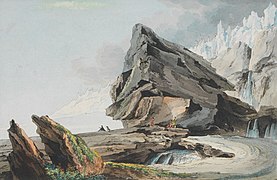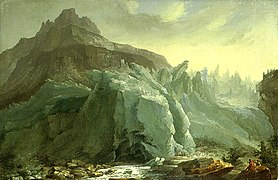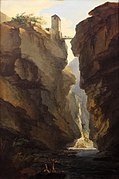Caspar Wolf

Caspar Goar Wolf (born May 3, 1735 in Muri AG ; † October 6, 1783 in Heidelberg ) is one of the most important Swiss painters of the pre-Romantic era and is considered a pioneer of high mountain painting . European art history is paying increasing attention to him as an important representative of the new era between the Enlightenment and Romanticism.
biography
Wolf was the son of a carpenter who fell into poverty. When he was fourteen, he was able to complete an apprenticeship as a church and landscape painter thanks to the support of the abbot of Muri . Afterwards he traveled from Munich to Passau and Augsburg and probably met Jakob Christoph Weyermann , a Swiss landscape painter. Johann Elias Ridinger , Gottfried Eichler , Georg Hertel , Jeremias Wachsmuth and Johann Wolfgang Baumgartner also worked in Augsburg, where a Protestant art academy was founded in 1710 .
In 1760 he returned to Muri and painted altars for chapels and monasteries. The paintings on the paneling and wallpaper on the first floor of Horben Castle , the summer residence of the Benedictine monks of Muri at the time, also come from him. In 1768/1769 Wolf was in Basel. In 1770 he moved to Paris, but returned to Muri the following year.
From 1773 he went on several study trips to the Bernese Oberland , as a companion of the theologian Jakob Samuel Wyttenbach and the influential Bernese publisher Abraham Wagner . Her role model was Albrecht von Haller , who (long before Jean Jacques Rousseau ) extolled mountain nature. They visited the St. Beatus Caves , the Staubbach Falls , the Fiescher Glacier , the Engelberger Rotstock , Muota , Guttannen , Leukerbad and the Geltenbach Cave . In 1777 he had painted around 170 original paintings of glaciers, seracs , caves, valleys and peaks. The next year, the Vues Remarquables were published as an aquatint in four colors, but without much success.
From 1777 to 1779 he was in Solothurn . Then Wagner, Johann Heinrich Füssli and Wolf traveled to Paris. Wolf worked with Philipp Jakob Loutherburg the Younger until he left for London. Wolf was influenced in Paris by Claude Joseph Vernet , one of the most famous landscape painters of the time. Under Vernet's direction, copper engravings of his Alpine paintings were also made on behalf of a Swiss publisher. The paintings were exhibited as a closed cabinet of alpine paintings in Paris and Bern and later reached Keukenhof Castle in the Netherlands. It is still unknown how these works got there.
From 1780 Wolf lived in Spa, Aachen (where he cured for kidney failure ), Cologne, Düsseldorf and at Bensberg Castle . He drew panoramas, villages, churches, parks, cities and, for example, Bensberg Castle and Benrath Castle . In June 1781 he stayed in Düsseldorf and offered the Düsseldorf Art Academy "80 presentations of the Alpine mountains in water color ... for sale at the gallery ". When his health improved, he went to Schwetzingen Castle and Heidelberg, where he died forgotten and impoverished in the hospital. In 1785, 43 of his around 200 Alpine landscapes in Amsterdam were published by Rudolf Samuel Henzi . His wife, whom he married in 1760, died in Muri in 1813.
Style and meaning
Before Wolf, depictions of the Alps can be found almost exclusively in products of purely documentary vedute painting . Wolf's significant innovation was the idealization of the alpine landscape through unusual perspectives, for example out of caves or through gorges, as well as through dramatic lighting. Caspar Wolf's tiny figure staffage is often in clear contrast to the vast expanse of the mountain landscape. Wolf also turns against the tendencies of the time towards harmonious landscape design, as found in Rococo and Classicism , for example with Jakob Philipp Hackert , and shows the viewer the elemental force of nature.
All of the stylistic features mentioned acquired special significance in painting during the German Romantic period . Along with Adrian Zingg , Johann Jakob Biedermann and Johann Georg von Dillis , Caspar Wolf is one of the most important forerunners of Romanticism.
Museums
The Caspar Wolf Museum is located in the Muri Monastery and claims to be the largest permanent exhibition of the artist's works. Further extensive groups of works can be seen in the Aargauer Kunsthaus and in the Museum Oskar Reinhart in Winterthur. The Kunsthaus Zürich and the Kunstmuseum Sion are also showing individual exhibits by the artist.
Until February 1, 2015, the Kunstmuseum Basel dedicated a special exhibition to Caspar Wolf.
Works (selection)
gallery
Waterfall near Balm near Günsberg
Other major works
- The Staubbach Falls in Lauterbrunnen Valley , around 1775
- View from the Beatushöhle on Lake Thun , 1776
- The Lauteraar Glacier with a view of the Lauteraarsattel , 1776
- The Rhone Glacier from the valley floor near Gletsch , 1778
- Draftsman in a Jura cave , 1778
literature
- Carl Brun : Wolf (f), Kaspar . In: Allgemeine Deutsche Biographie (ADB). Volume 43, Duncker & Humblot, Leipzig 1898, p. 777 f.
- Willi Raeber: Caspar Wolf. 1735-1783. His life and work. A contribution to the history of Swiss painting in the 18th century. (= Oeuvre catalogs of Swiss artists 7). Sauerländer et al., Aarau et al. 1979, ISBN 3-7941-1846-4 .
Fiction
- Hans-Ulrich Mielsch: The Alpine Gallery. A novel about Caspar Wolf, the pioneer of alpine painting. Arche Verlag, Zurich / Hamburg 2005, ISBN 3-7160-2340-X .
Web links
- Literature by and about Caspar Wolf in the catalog of the German National Library
- Sandi Paucic: Wolf, Caspar. In: Sikart
- Works by Caspar Wolf at Zeno.org .
- Caspar Wolf Museum in Muri Monastery
swell
- ^ Martin and Michaela Allemann-Koch: Caspar Goar Wolf. (PDF) (No longer available online.) Murikultur Foundation, 2003, archived from the original on May 3, 2016 ; Retrieved May 3, 2016 . Info: The archive link was inserted automatically and has not yet been checked. Please check the original and archive link according to the instructions and then remove this notice.
- ↑ Kunstmuseum Kunstpalast ( page no longer available , search in web archives ) Info: The link was automatically marked as defective. Please check the link according to the instructions and then remove this notice.
- ↑ Exhibition in Muri ( Memento of the original from August 28, 2009 in the Internet Archive ) Info: The archive link has been inserted automatically and has not yet been checked. Please check the original and archive link according to the instructions and then remove this notice.
- ^ Michael Maier: Albert Bierstadt: Rocky Mountains - Lander's Peak. Master's thesis, Heidelberg 1999, p. 28, PDF file, accessed in the archiv.ub.uni-heidelberg.de portal on August 18, 2013.
- ↑ School concrete magazine , 5/2012.
- ↑ Kunstmuseum Basel | Home. Retrieved December 18, 2014 .
| personal data | |
|---|---|
| SURNAME | Wolf, Caspar |
| ALTERNATIVE NAMES | Wolf, Caspar Goar (full name) |
| BRIEF DESCRIPTION | Swiss pre-romantic painter |
| DATE OF BIRTH | May 3, 1735 |
| PLACE OF BIRTH | Muri AG |
| DATE OF DEATH | October 6, 1783 |
| Place of death | Heidelberg |







